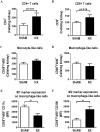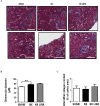Liraglutide Reduces Both Atherosclerosis and Kidney Inflammation in Moderately Uremic LDLr-/- Mice
- PMID: 27992511
- PMCID: PMC5161477
- DOI: 10.1371/journal.pone.0168396
Liraglutide Reduces Both Atherosclerosis and Kidney Inflammation in Moderately Uremic LDLr-/- Mice
Abstract
Chronic kidney disease (CKD) leads to uremia. CKD is characterized by a gradual increase in kidney fibrosis and loss of kidney function, which is associated with a progressive increase in risk of atherosclerosis and cardiovascular death. To prevent progression of both kidney fibrosis and atherosclerosis in uremic settings, insight into new treatment options with effects on both parameters is warranted. The GLP-1 analogue liraglutide improves glucose homeostasis, and is approved for treatment of type 2 diabetes. Animal studies suggest that GLP-1 also dampens inflammation and atherosclerosis. Our aim was to examine effects of liraglutide on kidney fibrosis and atherosclerosis in a mouse model of moderate uremia (5/6 nephrectomy (NX)). Uremic (n = 29) and sham-operated (n = 14) atherosclerosis-prone low density lipoprotein receptor knockout mice were treated with liraglutide (1000 μg/kg, s.c. once daily) or vehicle for 13 weeks. As expected, uremia increased aortic atherosclerosis. In the remnant kidneys from NX mice, flow cytometry revealed an increase in the number of monocyte-like cells (CD68+F4/80-), CD4+, and CD8+ T-cells, suggesting that moderate uremia induced kidney inflammation. Furthermore, markers of fibrosis (i.e. Col1a1 and Col3a1) were upregulated, and histological examinations showed increased glomerular diameter in NX mice. Importantly, liraglutide treatment attenuated atherosclerosis (~40%, p < 0.05) and reduced kidney inflammation in NX mice. There was no effect of liraglutide on expression of fibrosis markers and/or kidney histology. This study suggests that liraglutide has beneficial effects in a mouse model of moderate uremia by reducing atherosclerosis and attenuating kidney inflammation.
Conflict of interest statement
Novo Nordisk markets liraglutide for the treatment of diabetes and obesity. LSB, SER, CM, AR, and LFIN have been or are employed by Novo Nordisk A/S. This affiliation does not alter our adherence to PLOS ONE policies on sharing data and materials. The other authors declared no competing interests.
Figures





Similar articles
-
The GLP-1 receptor agonist liraglutide inhibits progression of vascular disease via effects on atherogenesis, plaque stability and endothelial function in an ApoE(-/-) mouse model.Diab Vasc Dis Res. 2013 Jul;10(4):353-60. doi: 10.1177/1479164113481817. Epub 2013 May 14. Diab Vasc Dis Res. 2013. PMID: 23673376
-
Liraglutide treatment improves endothelial function in the Ldlr-/- mouse model of atherosclerosis and affects genes involved in vascular remodelling and inflammation.Basic Clin Pharmacol Toxicol. 2021 Jan;128(1):103-114. doi: 10.1111/bcpt.13486. Epub 2020 Oct 8. Basic Clin Pharmacol Toxicol. 2021. PMID: 32896073
-
Effect of uremia on HDL composition, vascular inflammation, and atherosclerosis in wild-type mice.Am J Physiol Renal Physiol. 2007 Oct;293(4):F1325-31. doi: 10.1152/ajprenal.00039.2007. Epub 2007 Aug 8. Am J Physiol Renal Physiol. 2007. PMID: 17686960
-
[The extra-glycemic effects of liraglutide: focus on cardiometabolic markers].G Ital Cardiol (Rome). 2016 Apr;17(4):253-8. doi: 10.1714/2214.23896. G Ital Cardiol (Rome). 2016. PMID: 27093208 Review. Italian.
-
Liraglutide - overview of the preclinical and clinical data and its role in the treatment of type 2 diabetes.Diabetes Obes Metab. 2011 Mar;13(3):207-20. doi: 10.1111/j.1463-1326.2010.01330.x. Diabetes Obes Metab. 2011. PMID: 21205109 Review.
Cited by
-
Lack of Rab27a attenuates foam cell formation and macrophage inflammation in uremic apolipoprotein E knockout mice.J Mol Histol. 2023 Jun;54(3):183-193. doi: 10.1007/s10735-023-10125-w. Epub 2023 May 11. J Mol Histol. 2023. PMID: 37166546
-
Dulaglutide exerts beneficial anti atherosclerotic effects in ApoE knockout mice with diabetes: the earlier, the better.Sci Rep. 2021 Jan 14;11(1):1425. doi: 10.1038/s41598-020-80894-x. Sci Rep. 2021. PMID: 33446799 Free PMC article.
-
The Chicken Pan-Genome Reveals Gene Content Variation and a Promoter Region Deletion in IGF2BP1 Affecting Body Size.Mol Biol Evol. 2021 Oct 27;38(11):5066-5081. doi: 10.1093/molbev/msab231. Mol Biol Evol. 2021. PMID: 34329477 Free PMC article.
-
Mechanisms of Cardiorenal Protection of Glucagon-Like Peptide-1 Receptor Agonists.Adv Chronic Kidney Dis. 2021 Jul;28(4):337-346. doi: 10.1053/j.ackd.2021.06.001. Adv Chronic Kidney Dis. 2021. PMID: 34922690 Free PMC article. Review.
-
Myeloperoxidase-derived oxidants damage artery wall proteins in an animal model of chronic kidney disease-accelerated atherosclerosis.J Biol Chem. 2018 May 11;293(19):7238-7249. doi: 10.1074/jbc.RA117.000559. Epub 2018 Mar 26. J Biol Chem. 2018. PMID: 29581235 Free PMC article.
References
-
- Sarnak MJ, Levey AS, Schoolwerth AC, Coresh J, Culleton B, Hamm LL, et al. Kidney disease as a risk factor for development of cardiovascular disease: a statement from the American Heart Association Councils on Kidney in Cardiovascular Disease, High Blood Pressure Research, Clinical Cardiology, and Epidemiology and Prevention. Circulation. 2003;108(17):2154–69. 10.1161/01.CIR.0000095676.90936.80 - DOI - PubMed
-
- U.S. Renal Data System, USRDS 2013 Annual Data Report: Atlas of Chronic Kidney Disease and End-Stage Renal Disease in the United States, National Institutes of Health, National Institute of Diabetes and Digestive and Kidney Diseases, Bethesda, MD, 2013.
MeSH terms
Substances
LinkOut - more resources
Full Text Sources
Other Literature Sources
Medical
Molecular Biology Databases
Research Materials
Miscellaneous

